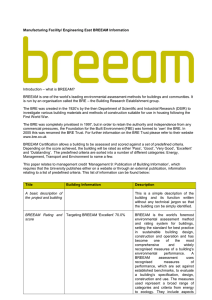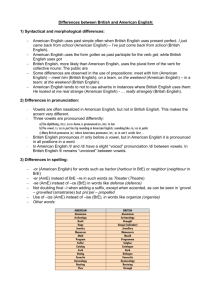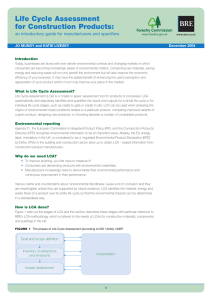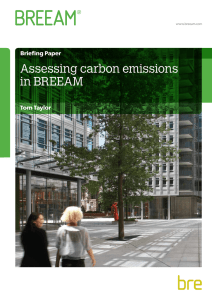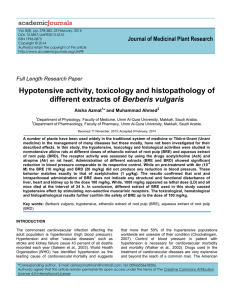Construction Waste Strategy
advertisement
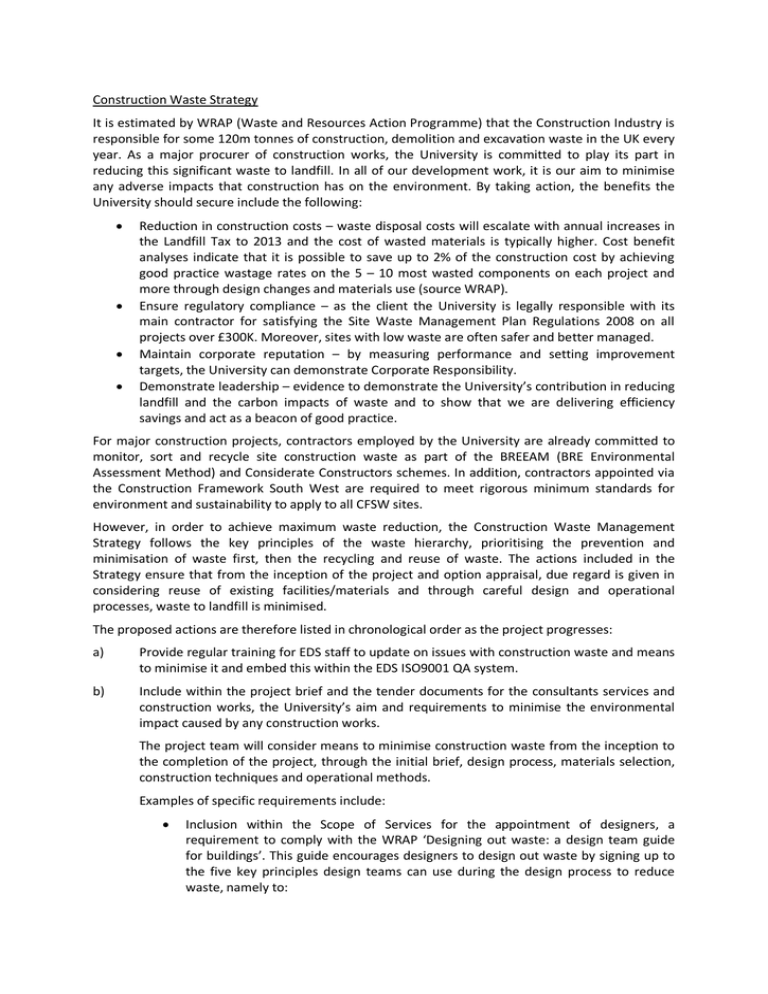
Construction Waste Strategy It is estimated by WRAP (Waste and Resources Action Programme) that the Construction Industry is responsible for some 120m tonnes of construction, demolition and excavation waste in the UK every year. As a major procurer of construction works, the University is committed to play its part in reducing this significant waste to landfill. In all of our development work, it is our aim to minimise any adverse impacts that construction has on the environment. By taking action, the benefits the University should secure include the following: • • • • Reduction in construction costs – waste disposal costs will escalate with annual increases in the Landfill Tax to 2013 and the cost of wasted materials is typically higher. Cost benefit analyses indicate that it is possible to save up to 2% of the construction cost by achieving good practice wastage rates on the 5 – 10 most wasted components on each project and more through design changes and materials use (source WRAP). Ensure regulatory compliance – as the client the University is legally responsible with its main contractor for satisfying the Site Waste Management Plan Regulations 2008 on all projects over £300K. Moreover, sites with low waste are often safer and better managed. Maintain corporate reputation – by measuring performance and setting improvement targets, the University can demonstrate Corporate Responsibility. Demonstrate leadership – evidence to demonstrate the University’s contribution in reducing landfill and the carbon impacts of waste and to show that we are delivering efficiency savings and act as a beacon of good practice. For major construction projects, contractors employed by the University are already committed to monitor, sort and recycle site construction waste as part of the BREEAM (BRE Environmental Assessment Method) and Considerate Constructors schemes. In addition, contractors appointed via the Construction Framework South West are required to meet rigorous minimum standards for environment and sustainability to apply to all CFSW sites. However, in order to achieve maximum waste reduction, the Construction Waste Management Strategy follows the key principles of the waste hierarchy, prioritising the prevention and minimisation of waste first, then the recycling and reuse of waste. The actions included in the Strategy ensure that from the inception of the project and option appraisal, due regard is given in considering reuse of existing facilities/materials and through careful design and operational processes, waste to landfill is minimised. The proposed actions are therefore listed in chronological order as the project progresses: a) Provide regular training for EDS staff to update on issues with construction waste and means to minimise it and embed this within the EDS ISO9001 QA system. b) Include within the project brief and the tender documents for the consultants services and construction works, the University’s aim and requirements to minimise the environmental impact caused by any construction works. The project team will consider means to minimise construction waste from the inception to the completion of the project, through the initial brief, design process, materials selection, construction techniques and operational methods. Examples of specific requirements include: • Inclusion within the Scope of Services for the appointment of designers, a requirement to comply with the WRAP ‘Designing out waste: a design team guide for buildings’. This guide encourages designers to design out waste by signing up to the five key principles design teams can use during the design process to reduce waste, namely to: • • • • • • • Design for reuse and recovery; Design for off site construction; Design for materials optimisation; Design for waste efficient procurement Design for deconstruction and flexibility. Production of whole life cycle costs for key structural and services elements of construction projects during the design process. Inclusion within the EDS ISO9001 QA system, as part of the briefing process for refurbishment/alterations projects, a requirement for the Project Manager/Designer to question the need to replace fittings and fixtures in buildings, where it is economically viable to retain them. c) To procure all new construction works via the Construction Framework South West (value over £1m) as the norm. d) To ensure that for all major capital projects, contractors are members and implement the requirements of the Considerate Constructors Scheme. e) To seek a minimum BREEAM rating for new build projects of ‘Excellent’ and ‘Very Good’ for major refurbishment. f) For new build construction projects, set targets for and measure waste reduction, using benchmark data for Education projects, collected by the BRE (Building Research Establishment). The BRE is a world leading organisation which carries out research in construction matters and the Built Environment. The BRE was tasked by DEFRA to advise on construction waste and provide benchmarking data. It collected waste data, based on minimum reporting requirements (developed in consultation with industry) and used this data to form selfupdating performance indicators and benchmark figures. Data from the benchmarking website, BRE’s SMARTStart system (a waste management system used by contractors to assess and target waste at the outset of their construction projects and then monitor actual waste consumption against targets) and the SMARTWaste Plan, have been used to develop the Performance Indicators. The performance indicators are based on actual volumes for completed new build projects and are currently measured and updated every three months. The key performance indicators used are m3 waste per 100m2 floor area and m3 waste per £100k project value. The University will aim to make a target reduction against these benchmarks of 5% by 2012 and 10% by 2015. It should be noted that over the periods of target reduction, it is likely that construction companies will continue to drive waste consumption down for legal, economic and corporate responsibility reasons. Therefore, the data the companies submit for their completed projects should show a trend of improvement in waste reduction for similar projects carried out over the period 2010-15. As the BRE benchmarks are continually updated to take account of new data submitted, over the monitoring period, the 5% and 10% target reductions against latest benchmark are likely to become greater in real terms than if measured against current performance indicators. The SMARTWaste system is a nationally recognised waste management and benchmarking system and as such, an additional point for using this system is awarded as part of the BREEAM assessment, thus improving the opportunity to gain the required BREEAM ratings identified in item e) above. g) As more data becomes available from the BRE and performance indicators are developed, similar targets will be set for waste reduction for demolition and refurbishment projects. (Benchmarks are currently under development). h) Require construction contractors on the University’s In Tend list for minor works (£25K to £1M) to be accredited with the Green Accord scheme or similar, in order to demonstrate best practice and promotion of reduction in environmental impact in carrying out their business. (This will be implemented when contractors are next invited onto the list in 2012). The construction waste strategy and targets within will be reviewed in 2013. Frances Vowles Deputy Director, Estate Development Service January 2011 (revision V1)
